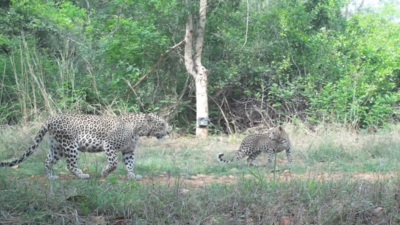ARTICLE AD BOX

Two leopard cubs camera trapped in Turahalligudda Minor Forests
BENGALURU: Bengaluru, known as the only state capital with a tiger population in its vicinity, has added yet another feather to its cap. With around 85 leopards on its outskirts, the tech capital of the country has overtaken Mumbai’s documented population of 54 leopards to become the largest metropolis with the highest known number of free-ranging big cats.
A year-long study of the city’s surrounding landscape, conducted using camera traps by wildlife biologists, revealed the presence of 85 leopards in the vicinity.Even though the city was aware of leopards around its outskirts, not many knew their actual numbers. To document the population, Sanjay Gubbi and his team of researchers from the Holematthi Nature Foundation (HNF) set up camera traps over the past few years and studied the cats' population and behaviour.
Covering a total of 282 sq km of mixed habitat spread over Turahalli, Turahalli Gudda, BM Kaval, UM Kaval, Roerich Estate, Gollahalli Gudda, Sulikere, Hesaraghatta, Marasandra, Manduru, and Bannerghatta National Park with 250 cameras, researchers documented 85 leopards.

A male leopard camera trapped in Sulikere Reserved Forests
“Out of these, a total of 54 leopards were recorded inside Bannerghatta National Park (BNP), and the remaining are spread across forested patches in South, North, and East Bengaluru.
This is more than the 54 leopards recorded around Mumbai (Sanjay Gandhi National Park). Apart from these free-ranging big cats, Bengaluru is the only metro in the country whose fringes still support an ensemble of tigers, leopards, dholes, elephants, gaur, sambar, and other large mammals.
People must also be credited for their success in coexisting,” explained Sanjay Gubbi.Interestingly, of the 85 leopards, 54 were found within BNP, and the remaining 30-plus roam around the reserved, deemed, and private forested patches in South, East, and North Bengaluru. “The density of leopards is high in South Bengaluru due to undisturbed patches of forest,” Gubbi pointed out. Leopard numbers are on the rise in Bengaluru!The research team, which documented leopards in BNP, found that their population has been steadily increasing each year. While the leopard population at BNP was around 40 in 2019, it rose to 47 in 2020, and now in 2025, it stands at 54. “This increase is largely due to the strict protection of habitat, resulting in an improved prey base.
The translocation of conflict leopards from other districts has also contributed slightly to these numbers,” said Gubbi, along with Shravan Suthar, Sandesh Appu Naik, Poornesha H C, Mayur Mirashi, and Aishwarya Karanth, who were part of the study team.Besides leopards, the camera traps recorded 34 other mammal species, including four endangered (tiger, dhole, elephant, and Indian pangolin) and four near-threatened (leopard, rusty-spotted cat, mouse deer, and painted woolly bat) species in the vicinity of Bengaluru. “The numbers suggest that the government must protect and conserve the existing natural habitats, especially in South Bengaluru, to avoid future conflict. Declaring Hesaraghatta as a conservation reserve will also help,” Gubbi added.What Future Demands?
- Notify BM Kaval, UM Kaval, Roerich Estate, and Gollahalli Gudda as a Conservation Reserve—a long-term “lung space” for Bengaluru.
- Add Durgadakal RF, Bettahalliwade RF (Block B), and the deemed forests of JI Bachahalli and M Maniyambal to BNP, where tigers have been sighted.
- Safeguard the Muneshwarabetta–Bannerghatta wildlife corridor through appropriate conservation measures.
- Intensify community outreach so Bengaluru’s rapidly expanding suburbs can coexist safely with leopards.
- Halt further translocation of leopards into BNP; instead, address the root causes of human–leopard conflict at the source sites.
Get the latest lifestyle updates on Times of India, along with Eid wishes, messages, and quotes !



.png)
.png)
.png)
















 16 hours ago
3
16 hours ago
3









 English (US) ·
English (US) ·